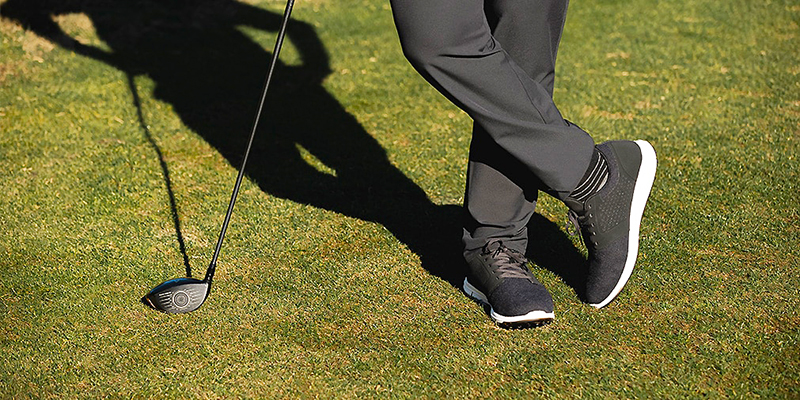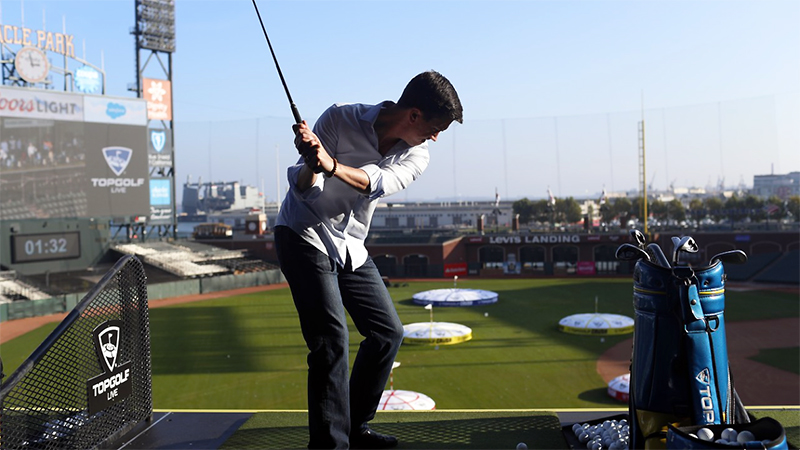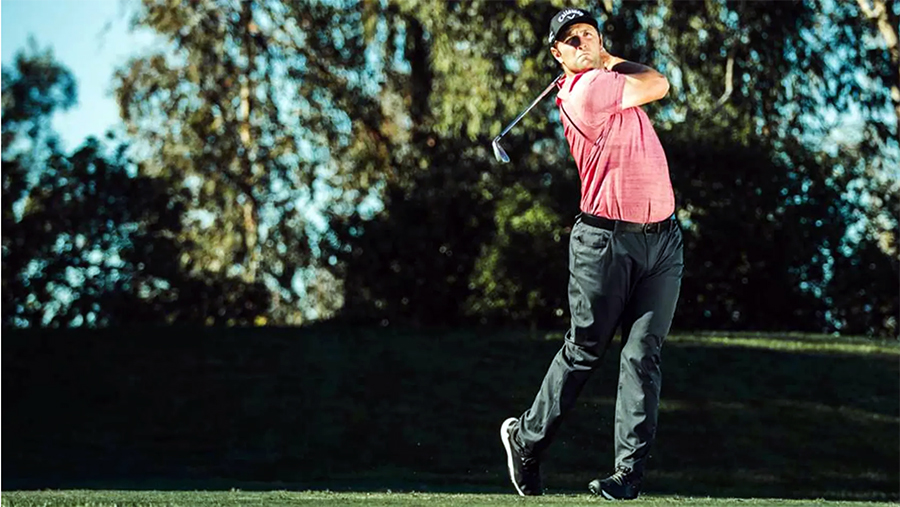Callaway Golf Company CEO Chip Brewer let out a “wow” when looking back at 2020 during a recent conference call with analysts to discuss 2020 fourth quarter and full-year results.
“We started with business as usual, survived an unforeseen global shutdown, working our way through it in a manner that ensured we came through in a position of strength,” Brewer offered. “Then, as the world opened back up, we emerged to find golf experiencing record demand and participation levels. Finally, we finished the year announcing a transformational merger with Topgolf, signing Jon Rahm and delivering on some key strategic initiatives.”
By any measure, that would be seen as a big year for any business, but it must have been all the more satisfying in a business invested so heavily in the golf category, which was given up for dead by many analysts a year ago.
“Looking at Q4 in isolation, the operating results in our golf equipment segment continued the strong momentum shown in Q3, while the apparel business returned to growth and showed great signs for the future,” Brewer continued. “On the Topgolf side, we continued to make progress on the merger with our shareholder vote scheduled for March 3 and hopefully closing shortly thereafter.”
Callaway reported record consolidated fourth-quarter net sales in 2020, posting 20.1 percent growth to $375 million, compared to $312 million in the prior-year period. Company EVP and CFO Brian Lynch suggested on the call that the increase was driven by a 40 percent increase in the golf equipment segment resulting from the high demand for golf products late into the year, and “the strength of the company’s product offerings across all skill levels.”
Brewer added that the golf equipment segment continued to experience unprecedented demand globally as interest in the sport and participation surged.
According to Golf Datatech, U.S. retail sales of golf equipment, specifically hardgoods, were up 59 percent during Q4 — the highest Q4 ever on record — results that followed the highest Q3 on record as well. U.S. rounds were up 41 percent in Q4, according to Brewer’s read on the Golf Datatech reports, and delivered 14 percent growth for the full year despite the shutdowns earlier in the year.
“We continue to believe there will be a long-term benefit from the increased participation as we are welcoming new entrants and returning golfers to our sport,” opined Brewer. “Golf retail outside of resort location remains very strong at present, while inventory at golf retail remains at all-time lows. These low inventory levels will likely continue at least through Q1.”
The company said that the Callaway brand’s global hardgoods market share remained strong during the quarter. Management estimated that the U.S. market share across all channels grew slightly during Q4 and for the full year 2020. Brewer said Callaway’s share in Japan was also up slightly for the full year, allowing the brand to finish 2020 as the number one hardgoods brand in that market. “This is the first time that a non-Japanese brand has ever finished number one for the full-year in total hardgoods,” concluded Brewer. The brand’s full-year share in Europe was said to be “down slightly,” but the company laid claim to the number on3 hardgoods brand moniker in there.
“On a global basis, we remain a leading club company in terms of both market share and total revenues and the number two ball company,” said Brewer. “In the U.S., third-party research showed our brand to be the number one club brand in overall brand rating and the leader in innovation and technology.”
The company’s soft goods segment continued its “faster-than-expected recovery,” with fourth-quarter 2020 sales increasing one percent versus the 2019 comparable quarter. Changes in foreign currency rates reportedly had a $9 million favorable impact on fourth-quarter 2020 net sales.

Brewer said the softgoods and apparel segments of the company’s business, which includes the Callaway brand, TravisMathew and Jack Wolfskin, were more impacted by the pandemic during the fourth quarter, a trend he suggested mirrored the trend in the apparel industry in general. He said the speed and magnitude of the recovery continued to exceed expectations.
The Callaway Golf brand apparel business in Japan reportedly had a good quarter and was said to finish the year as the number one golf apparel brand in its market based on market share. In Korea, the company plans to take back the Callaway Golf apparel brand licensed to a third party for several years and launched its own apparel business during the second half of 2021.
Brewer said the TravisMathew brand and business “continues to impress.” He noted its brand momentum is “extremely strong, both in direct-to-consumer channels and at wholesale.” He said they are increasingly confident this could be a large and highly profitable brand, presenting them an even more significant opportunity than initially anticipated. ELY has been investing in TravisMathews’s systems and supply chain infrastructure, which will continue through 2021 and then taper off. “We are also investing in direct-to-consumer efforts, both through the addition of new stores, selectively taking advantage of some great opportunities and, of course, e-commerce. We could not be more excited about this business overall.
Jack Wolfskin also reportedly had a strong quarter, delivering “year-over-year revenue growth.” Perhaps even more importantly, the company cleared key strategic and operational hurdles during the quarter.
Brewer said that before the full European retail shutdown in mid-December, the sell-through of the fall/winter Jack Wolfskin line was excellent in both Europe and China. In China, Q4 was the first quarter to showcase the local product design by a new team recruited in 2019. “The success of this new China-for-China product was a key strategic initiative for us,” said Brewer. “Globally, but especially in key markets of China and Europe, we believe the combination of strong leadership and sell-through momentum bodes well for the brand as markets open up and recover.”
The company’s apparel business was significantly strengthened in the e-commerce channel by investments made before the pandemic and continues to be funded. “These investments enabled our apparel business e-comm to deliver 64 percent year-over-year growth in Q4,” detailed Brewer. “E-comm is now a significant portion of the channel mix of this segment, and we are confident our expanded capabilities and strength here will bolster the business growth prospects and profitability in the future.”
Brewer wrapped up his apparel segment comments with forecasting. “Post-COVID-19, we continue to expect our apparel and soft goods segment to grow faster than our golf equipment business and with that growth, to deliver operating leverage and enhanced profitability,” he said. “And although the pandemic delayed our efforts, we believe we’ll be able to deliver $15 million of synergies in this segment over the coming years.”
Turning to Topgolf, the comments were limited as they have not closed the transaction yet. During late Q4, three of Topgolf U.S. venues were forced to shut due to COVID-19 restrictions and three U.K. venues. Despite the headwinds, Topgolf’s overall results exceeded expectations in Q4, according to Brewer’s comments. He said the business was driven primarily by strong walk-in sales. Topgolf has opened two new domestic venues in 2021, one in Lake Mary, FL, and Albuquerque, NM. Both are reportedly on track to hit their venue plan of eight newly owned venues for 2021. On the international front, Topgolf’s third franchise opened earlier this year in Dubai. “The site has been getting stronger views despite ongoing COVID-19 complications in this market, and we expect this to be a flagship site for us internationally,” Brewer said.

Currently, only the U.K. and Portland, OR venues are closed. And COVID-19 restrictions appear to be easing. “Despite 2021 starting with more COVID-19 restrictions than we expected, strong walk-in traffic is allowing this business to continue to perform at a level consistent with achieving our total venue full-year same venue sales target of 80 percent to 85 percent of 2019 levels,” Brewer suggested.
ELY gross margin declined 460 basis points to 37.1 percent of sales in the fourth quarter, compared to 41.7 percent in the prior-year period. On a non-GAAP basis, the company reported that gross margin was 37.2 percent in Q4 compared to 42.4 percent in Q4 2019, a decrease of 520 basis points. Lynch said the GM decrease is primarily attributable to the company’s “proactive inventory reduction initiatives in the soft goods segment, increased operational costs due to COVID-19 and increased freight costs associated with higher rates and a higher mix of air shipments to meet demand.” These decreases were partially offset by favorable changes in foreign currency exchange rates and a favorable mix created by an increase in the company’s e-commerce sales.
Operating expenses were $171 million in Q4 2020, an $18 million increase from the 2019 fourth quarter. Non-GAAP operating expenses for the fourth quarter were $162 million. This increase was reportedly driven by the “company’s decision to pay back to employees, other than executive officers, their reduced salary levels for a portion of the year; variable expenses related to the higher revenues in the quarter; continued investments in new businesses; and unfavorable changes in foreign currency exchange rates.”
Callaway’s pretax loss was $48 million in the fourth quarter, compared to the $32 million pretax loss for the 2019 comp period. The non-GAAP pretax loss was $35 million in the fourth quarter. ELY reported a loss per share of 43 cents in Q4, compared to a loss per share of 31 cents. The non-GAAP loss per share was 33 cents in the fourth quarter.
This stronger-than-expected recovery has contributed to a “significantly improved” liquidity position for Callaway golf. Available liquidity, which includes cash-on-hand plus availability under credit facilities, increased to $632 million at December 31, 2020, compared to $303 million at December 31, 2019. This additional liquidity reflects improved liquidity from working capital management, cost reductions and proceeds from the convertible notes issued during the second quarter. ELY had a total net debt of $406 million at year-end, including $442 million of principal outstanding under its term Loan B facility used to purchase Jack Wolfskin.
Inventory balance decreased by 22.8 percent to $353 million at quarter- and year-end. The decrease was primarily due to the high demand it is experiencing in the golf equipment business and inventory reduction efforts in the softgoods businesses.
Looking ahead, ELY did not provide 2021 guidance due to the “uncertainties of the COVID-19 situation globally” but did provide some color. Brewer said the golf equipment sector is likely to be “slightly impacted by COVID-19 in Q1 with the majority of European markets and portions of Asia and Tokyo, for instance, in some lockdown or retail constraint and with supply constraints based on both capacity limitations and logistics. We are also experiencing higher operating costs associated with COVID-19. Our container shipping costs alone are estimated to be up approximately $13 million for the full-year as these costs have surged, but we do not see this as a long-term issue, just a short-term anomaly associated with the pandemic.”
Brewer said the demand situation is strong enough that it expects a “very strong year in golf equipment despite these issues, a little constraint in Q1 based on capacity and logistics with increasing opportunity to catch up with demand in Q2.” He said the softgoods and apparel segments continue to be more impacted by COVID-19, with Europe shut down especially impactful for its business there, and “certainly through Q1.” However, he also said the key points of operating strategic progress, with the attractive long-term prospects of golf and outdoor lifestyle apparel, make him increasingly confident for this business post-COVID-19 closures and its short-term impact. He said, Topgolf is performing “consistent with plan,” with new venue openings on track, and that it is increasingly confident for the business overall. Brewer said it would have more to say on the Topgolf business starting with its next call if they close in March as planned.
“We continue to see this as a transformational opportunity, Brewer reiterated.”
Photos courtesy Calloway, TravisMathew, Topgolf
















